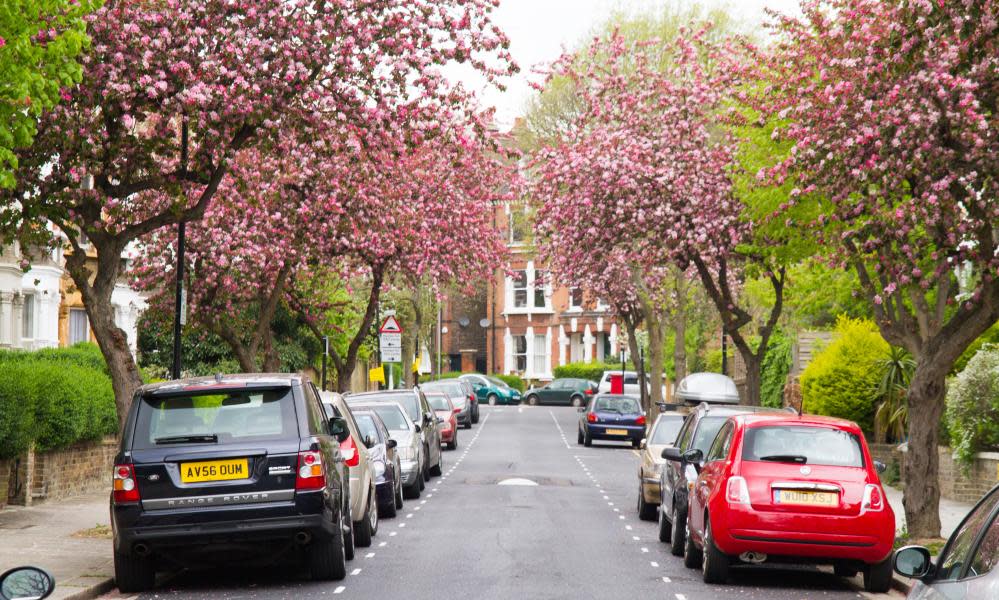A UK tree provides hundreds of pounds of benefits a year, report finds

The huge value of trees standing alone and in small groups in the UK has been revealed in a new report, which found they provide billions of pounds worth of benefits to people every year. The trees capture climate-heating CO2, reduce toxic air pollution and slow the flow of rainwater, cutting flood risks.
There are millions of such trees across the country, covering a combined 750,000 hectares, and making up 20% of all the nation’s trees. The value of woodland has already been estimated but the report is the first to calculate a value for trees in gardens, parks, fields and along streets across the UK.
It found the value of the services from non-woodland trees ranges from £1.4bn to £3.8bn a year, depending on the methodology used. The researchers said the estimates were conservative, as many benefits were hard to quantify, such as the boost to wildlife and to people’s mental health.
A large individual tree, with a canopy diameter of 30 metres, provides hundreds of pounds of benefits a year, the report found. It also estimated separately the average replacement cost of a tree at £2,500, although the largest trees can be valued at more than £100,000. In total, the report valued non-woodland trees at £429bn. The researchers said their work could be used by local authorities to justify the costs of protecting and planting trees at a time when budgets are hard-pressed.
Kieron Doick, head of the urban forest research group at Forest Research and lead author of the report, said the importance of single and small groups of trees struck him on a recent walk. “As I walked home, I was passing trees all around my town, along the highway, single ones in people’s gardens, some at the intersections,” he said. “It represented to me the diversity and coverage of the trees that are in our everyday lives, but are not in woodlands.”
“The numbers are substantial,” Doick said. “These trees are at least as valuable in terms of providing benefits to people as woodland trees and we still aren’t even considering all of the benefits.
“This research will help support decision-makers to justify the spending on the resource management, research and maintenance of our non-woodland trees in the same way they do our woodland trees.”
The report found the largest economic benefit from the non-woodland trees is the removal and storage of CO2, which accounted for a half to two-thirds of the benefit, depending on the methodology used. The removal of air pollution was also significant, contributing a fifth to a third of the benefits. Smaller but important other benefits were cooling local temperatures on hot days and screening people from noise pollution. Single urban and rural trees and groups of trees less than 0.5 hectares in area were included in the analysis.
Earlier research estimated the canopy cover of trees in 283 towns and cities in England at an average of 16%, with another study recommending this should rise to a minimum of 20%. A citizen science project to map urban canopy cover in the UK is being run by Forest Research and partners. Doick said the state of urban trees varied considerably: “In some cities, their population will have a very high percentage classed as in very good or excellent health. In other places, it will be less so.”
The government announced this week that 57 local authorities across England had received nearly £10m through the woodland creation accelerator fund to kickstart tree-planting activity. The forestry minister Trudy Harrison said: “Our trees, forests and woodlands are the nation’s lungs and serve as a powerful weapon in the fight against climate change. At a local level, trees are the lifeblood of communities, essential to supporting wellbeing.”
Adam Cormack, at the Woodland Trust, said: “This important new research shows the extraordinary financial value of the trees in our streets, our parks and our countryside, [which] should be worthy of the highest level of protection. Yet, we know this isn’t the case. For example, eastern England has lost 50% of its large trees in the past 150 years.”
The “incalculable cultural value” of trees was not covered by the research, Cormack said. “This is especially true for our oldest and most important trees, which don’t have the automatic legal protection that most of our wildlife and old buildings have. These astonishing trees are our inheritance from history, and we should be treating them like national treasures.”
Mike Childs, Friends of the Earth’s head of policy, said: “Estimating the economic value of trees is fraught with difficulties and inevitably fails to capture all the benefits. But the government shouldn’t need this type of exercise to realise that we need more trees in our towns, cities and countryside.”
“The government’s suggestion of increasing tree cover in England from 14.5% to 17.5% by 2050 is completely inadequate,” Childs said. “Instead, it should be aiming to double tree cover and ensure that every street and neighbourhood reaps the undoubted benefits from having trees on their doorstep.”
The benefits of the UK’s 3m hectares of woodlands was estimated in 2018 at £4.9bn a year, although it used a much lower value for carbon storage. A 2021 report found that walks taken by people in UK woodlands save £185m a year in mental-health costs.

 Yahoo Movies
Yahoo Movies 
